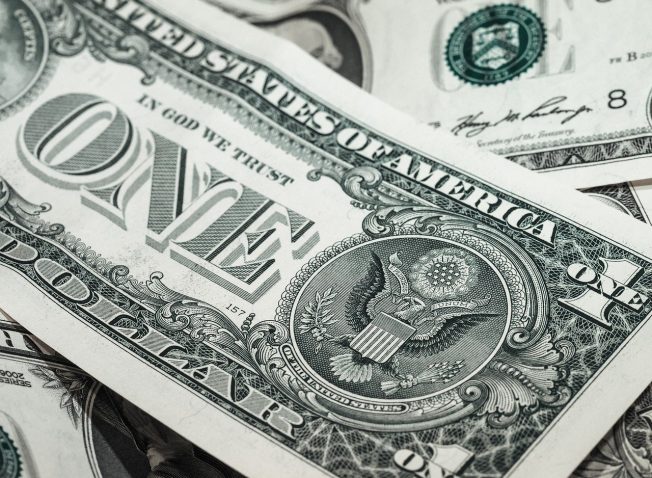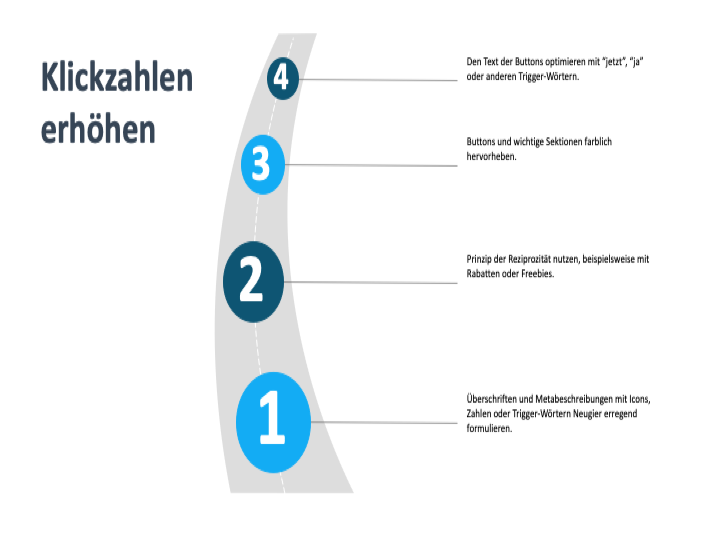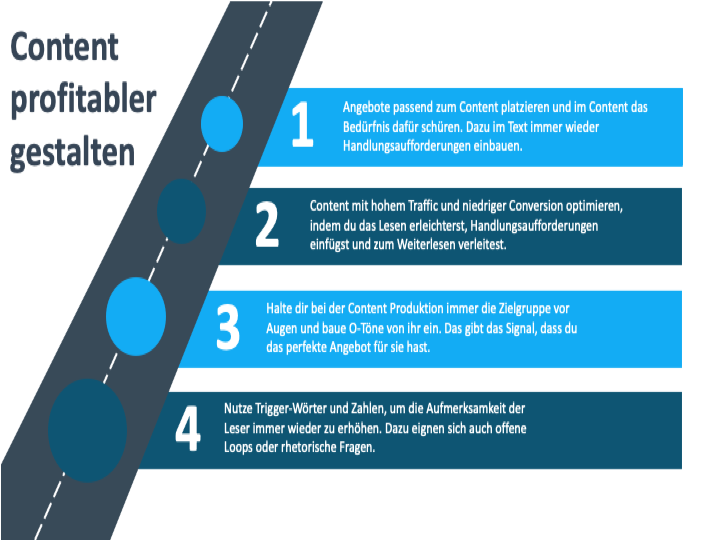Make money with content: Tips from sales psychology


Is it possible to earn money with content or is it merely a cost item that does not make a sustainable contribution to the company's success? This or a similar question is asked by many managing directors or employees from online marketing.
Content is never free, but always pays off for the company in the long term. Good content pays off faster and more intensively than "bad" content. But in the 6th step of content marketing, the analysis, it becomes clear which content specifically pays off for your goals and which less.
In this analysis, you can measure conversion and profitability as well as operational metrics. For example, whether deadlines are met by each team member, where things go wrong, how long the process from idea to publication takes, and which step requires the highest financial resources.
Today, I'm focusing on what the relevant numbers are for making money with content - and how sales psychology can help you do it.
{{divider}}
Create opportunities
In the 1st step, it is important to check if you are giving your readers or viewers a way to give you money.
- Do you have a call-to-action?
- Do you have a product or other offering that matches the copy, videos or other content formats you publish?
In order to make money with content, these options are essential. Many assume that users will click on the website on their own if they like the blog article.
But the reality is that content is consumed in between. Not everyone reads an article from A to Z, but scans it - reads individual passages and scrolls on again. Only in exceptional cases do they devote their full attention to your blog. That's why:
If you have an offer, communicate it. Point it out to your readers and viewers.
{{divider}}
Increase click-through rates in content marketing
All those who communicate their offer want higher click-through numbers. You can find out these numbers on several levels: What are the Google search clicks? How many click from the ad to the landing page? How many click from the blog article to the opt-in form? What are the clicks from the article description to the shopping cart? What are the email marketing open rates?
No matter what content you rely on - clicks always play an important role in the analysis. In the following, I will list some strategies to increase the number of clicks.
{{divider}}
Increase clicks from Google search
You've written an in-depth blog article that has already landed in the top 5 search results? Now you surely want searchers to click on your page and not on another one.
How you can achieve it:
Make sure you change the meta descriptions yourself. Many companies leave these to chance. But by changing them yourself, you can increase clicks and give searchers exactly the information you want them to have. When it comes to wording, make sure you think of them as headlines in their own right. For example, these elements that arouse curiosity are effective:
- Odd numbers
- Trigger words like secret, unknown, fast, immediate
- Special characters
- Highlight greatest advantages
- Questions
In recent years, green check marks have proven to be particularly useful as special characters, as they catch the eye directly in the SERPs. However, it is possible that this function will soon be disabled by Google. Until then, however, I would recommend you not to do without it.
In the longer meta description, you should include a call to action:
- Inform now
- Get more information now
- Equal read
- Find out now
- Learn more now
{{divider}}
Increase click-throughs on the opt-in box
Highly placed blog articles are a cheap and comparatively easy way to build your email list. While many do it with paid campaigns, you simply use your already existing traffic from your website. Now that you've brought searchers to your website, it's a matter of getting them to sign up.
From a sales psychology point of view - and you will already see it on most websites - a "gift" makes sense. For online stores or in the B2C sector, for example, discounts. You can also create lead magnets or freebies in the form of short e-books, a video series, a case study or similar.
Through this gift, 2 things happen: first, the incentive for your email list increases because the website visitors want this free content or discount. Secondly, the principle of reciprocity works here. This means that those who subscribe to your newsletter want to give something back to you because they got something for free from you.
However, to ensure that many people sign up, you can highlight the opt-in form in color. Place it prominently so that no one can simply "scroll past" it. Many people find pop-ups with this form annoying. However, they still generate the highest number of new signups.
You can also use language to get more people to sign up. For example, many people are concerned that you will send them spam, carelessly share their email addresses, or send 10 emails a day. Add in a small line in the opt-in form that you don't do all that because it's important to you that they feel comfortable with your newsletter. At the same time, you're framing it. (Framing comes from NLP and means that you draw a frame around a fact to make the picture appear in your mind). If you mention that you only send useful content, the chance of higher open rates increases.
The most important thing is the button with which your visitors finally sign in. Often "Sign in" or "Sign up" are used.
You'll get higher rates if you add a "now" in front of it. Even better, however, are phrases that refer to the added value of your lead magnet. So:
- Secure 5% discount now
- Learn 10 Content Marketing Strategies Now
- Get free analysis now
Depending on the industry, the small word "Yes" at the beginning is also suitable to bring the user into the Yes set. If he reads "yes", he is more likely to click the button.
Also highlight the button with a color so that it stands out. Animations or a mouse pointer on the button have also proven successful.

{{divider}}
Focus on high performance content
In the content analysis you divide the content into 4 categories:
- High traffic, high conversion
- High traffic, low conversion
- Low traffic, high conversion
- Low traffic, low conversion
When it comes to making money with your content, it makes sense above all to optimize content with high traffic and low conversion.
Let's take a closer look at the process:
Have you thought about calls to action that appear repeatedly (when it fits the content) in the text?
As mentioned above, you can optimize the button with the words "Yes" and "Now".
Does your call to action or offer match the content of your content? I often see blog articles and videos where the offer doesn't match what they are writing or talking about before.
To give you a concrete example, imagine that you're reading a blog article about saving electricity and then you're supposed to click to a gas price comparison. Yes, both have something to do with saving money, but you could make sure that the text and CTA are even better aligned.
To make money with your content, you can create the need to accept your offer in your content. Therefore, you should intensively engage with your target group. (This is important in every step of your content, by the way).
- What interests them?
- What do they hope to gain from your offer?
- Why do they prefer to take advantage of your offer rather than the competition's?
- What problem keeps them busy day and night?
- What is your most fervent wish?
Try to mention these points in every content piece to send a signal to the target audience:
You understand them and only produce products that really make their lives easier.
To do this, you can use so-called signal words:
- High quality
- Extravagant
- Noble
- Handmade
- Lightning fast
Also try to include original sounds from your target group in your content. This also sends a signal that you really understand your readers and that they can feel comfortable with you.
{{divider}}
How far does the reader scroll?
With various tools such as Google Analytics, you can track exactly how far your readers scroll or how long your video is viewed. This value is important. Because if the majority click away at a certain passage, you can change this passage.
Open loops have proven their worth. You tease something, which you resolve at the end. This creates curiosity and the need to stay until the end - and thus click on your CTA.
You know what increases attention again? It's (rhetorical) questions that you sprinkle into your content from time to time.
You should also check the content of this passage: Do you stray too far from the topic at this point? Is this passage really relevant or would the message of the content remain the same if you deleted this passage? Can you perhaps introduce an exciting new fact?

{{divider}}
Conclusion - How to earn money with content
Content marketing is a great way to achieve financial success with online marketing without spending a lot on advertising. To increase profitability even more, sales psychology helps you. For example, by using triggers, optimizing buttons and speaking in the language of your target audience. It's best not to optimize everything at once, but to test tip by tip. That way you can check exactly which lever is the most important in your case.
With contentbird, content analysis is easy and happens automatically. You even get a graphical listing of which content is worth optimizing. If you are curious now, you can test contentbird here 14 days for free:
Make money with content: Tips from sales psychology
contentbird.blog







